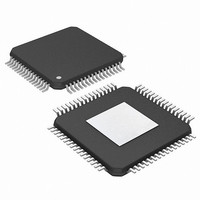PIC24FJ256DA210T-I/BG Microchip Technology, PIC24FJ256DA210T-I/BG Datasheet - Page 286

PIC24FJ256DA210T-I/BG
Manufacturer Part Number
PIC24FJ256DA210T-I/BG
Description
16-bit, 256KB Flash, 96K RAM, USB, Graphics 121 XBGA 10x10x1.20mm T/R
Manufacturer
Microchip Technology
Series
PIC® 24Fr
Specifications of PIC24FJ256DA210T-I/BG
Core Processor
PIC
Core Size
16-Bit
Speed
32MHz
Connectivity
I²C, IrDA, SPI, UART/USART, USB OTG
Peripherals
Brown-out Detect/Reset, GFX, LVD, POR, PWM, WDT
Number Of I /o
84
Program Memory Size
256KB (85.5K x 24)
Program Memory Type
FLASH
Ram Size
96K x 8
Voltage - Supply (vcc/vdd)
2.2 V ~ 3.6 V
Data Converters
A/D 24x10b
Oscillator Type
Internal
Operating Temperature
-40°C ~ 85°C
Package / Case
121-TFBGA
Lead Free Status / RoHS Status
Lead free / RoHS Compliant
Eeprom Size
-
Lead Free Status / RoHS Status
Lead free / RoHS Compliant
Available stocks
Company
Part Number
Manufacturer
Quantity
Price
Company:
Part Number:
PIC24FJ256DA210T-I/BG
Manufacturer:
Microchip Technology
Quantity:
10 000
- Current page: 286 of 408
- Download datasheet (4Mb)
PIC24FJ256DA210 FAMILY
20.1
The RTCC module registers are organized into three
categories:
• RTCC Control Registers
• RTCC Value Registers
• Alarm Value Registers
20.1.1
To limit the register interface, the RTCC Timer and
Alarm Time registers are accessed through the corre-
sponding register pointers. The RTCC Value register
window (RTCVALH and RTCVALL) uses the RTCPTR
bits (RCFGCAL<9:8>) to select the desired Timer
register pair (see Table 20-1).
By writing the RTCVALH byte, the RTCC Pointer value,
RTCPTR<1:0> bits, decrement by one until they reach
‘00’. Once they reach ‘00’, the MINUTES and
SECONDS value will be accessible through RTCVALH
and RTCVALL until the pointer value is manually
changed.
TABLE 20-1:
The Alarm Value register window (ALRMVALH and
ALRMVALL)
(ALCFGRPT<9:8>) to select the desired Alarm register
pair (see Table 20-2).
By writing the ALRMVALH byte, the Alarm Pointer
value bits, ALRMPTR<1:0>, decrement by one until
they reach ‘00’. Once they reach ‘00’, the ALRMMIN
and ALRMSEC value will be accessible through
ALRMVALH and ALRMVALL until the pointer value is
manually changed.
EXAMPLE 20-1:
DS39969B-page 286
asm
asm
asm
asm
asm
asm
RTCPTR
<1:0>
00
01
10
11
volatile("disi #5");
volatile("mov #0x55, w7");
volatile("mov w7, _NVMKEY");
volatile("mov #0xAA, w8");
volatile("mov w8, _NVMKEY");
volatile("bset _RCFGCAL, #13");
RTCC Module Registers
REGISTER MAPPING
uses
RTCVAL<15:8>
RTCVAL REGISTER MAPPING
RTCC Value Register Window
WEEKDAY
MINUTES
MONTH
SETTING THE RTCWREN BIT
—
the
ALRMPTR
RTCVAL<7:0>
SECONDS
HOURS
YEAR
DAY
bits
//set the RTCWREN bit
TABLE 20-2:
Considering that the 16-bit core does not distinguish
between 8-bit and 16-bit read operations, the user must
be aware that when reading either the ALRMVALH or
ALRMVALL
ALRMPTR<1:0> value. The same applies to the
RTCVALH or RTCVALL bytes with the RTCPTR<1:0>
being decremented.
20.1.2
In order to perform a write to any of the RTCC Timer
registers, the RTCWREN (RCFGCAL<13>) bit must be
set (refer to Example 20-1).
ALRMPTR
Note:
Note:
<1:0>
00
01
10
11
This only applies to read operations and
not write operations.
WRITE LOCK
To avoid accidental writes to the timer, it is
recommended that the RTCWREN bit
(RCFGCAL<13>) is kept clear at any
other time. For the RTCWREN bit to be
set, there is only 1 instruction cycle time
window allowed between the unlock
sequence and the setting of RTCWREN;
therefore, it is recommended that code
follow the procedure in Example 20-1.
For applications written in C, the unlock
sequence should be implemented using
in-line assembly.
bytes,
ALRMVAL<15:8> ALRMVAL<7:0>
ALRMVAL REGISTER
MAPPING
Alarm Value Register Window
ALRMMNTH
ALRMMIN
ALRMWD
they
2010 Microchip Technology Inc.
—
will
decrement
ALRMSEC
ALRMDAY
ALRMHR
—
the
Related parts for PIC24FJ256DA210T-I/BG
Image
Part Number
Description
Manufacturer
Datasheet
Request
R

Part Number:
Description:
Manufacturer:
Microchip Technology Inc.
Datasheet:

Part Number:
Description:
Manufacturer:
Microchip Technology Inc.
Datasheet:

Part Number:
Description:
Manufacturer:
Microchip Technology Inc.
Datasheet:

Part Number:
Description:
Manufacturer:
Microchip Technology Inc.
Datasheet:

Part Number:
Description:
Manufacturer:
Microchip Technology Inc.
Datasheet:

Part Number:
Description:
Manufacturer:
Microchip Technology Inc.
Datasheet:

Part Number:
Description:
Manufacturer:
Microchip Technology Inc.
Datasheet:

Part Number:
Description:
Manufacturer:
Microchip Technology Inc.
Datasheet:











